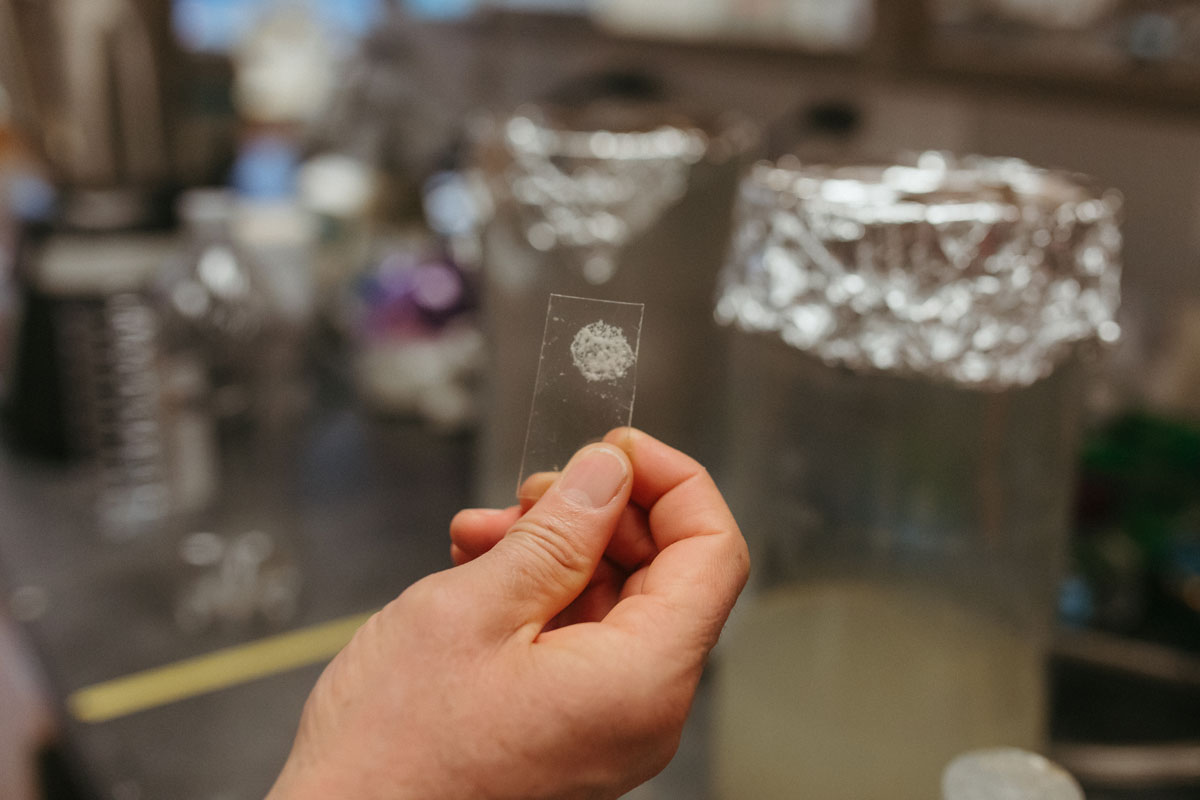These Microbes Eat Water Bottles
Reed College biologists develop colonies of bacteria that can break down plastic pollution.
It’s tough, it’s cheap, and it’s everywhere. Polyethylene terephthalate (PET) is found in running shirts, carpet fibers, curtains, solar panels, tennis balls, microwavable containers, and plastic bottles—about 500 billion bottles are manufactured out of PET every year. But the very qualities that make PET so useful also make it an environmental nightmare. Its incredible durability means that it persists for decades, clogging rivers, beaches, forests, and waterways. Some 8 million tons of plastic enters the ocean every year, according to a 2015 paper in Science, fueling the infamous Pacific trash vortex that is currently the size of Texas.
To get a handle on this gargantuan problem, researchers at Reed College are recruiting an infinitesimal ally.
In a groundbreaking paper published in mSphere, the open-source journal of the American Society for Microbiology, Prof. Jay Mellies and students at Reed reported on colonies of bacteria that can break down PET. Remarkably, the colonies do not consist of a single species—rather, they are composed of a consortium of five different types of bacteria that work synergistically to consume PET and convert it into a source of energy.
“The novelty of our work is that we are using a group of bacteria to biodegrade PET plastic, whereas most efforts to date have focused on individual, isolated enzymes for this purpose,” says Prof. Mellies.
The genesis for the project came from bio major Morgan Vague ’18, who studied the relationship between bacteria and plastic for her thesis with Prof. Mellies. She dug up samples of muck from around Galveston Bay in Texas to see if bacteria there might have evolved the ability to feed on hydrocarbons. She tried to culture bacteria on shards of water bottles; most died, but some stubbornly clung to life. Since PET was its only source of nutrition, she reasoned, it had to be digesting the plastic.
Prof. Mellies was thrilled. PET is notoriously nonbiodegradable. Chemically, it is a polymer, consisting of long tough strands of ethylene glycol and terephthalic acid monomers, all tangled up together. These strands lend PET its durability; they also make it virtually impervious to biological reaction. Yet somehow the bacteria had figured out a way to break it down.
With the support of a grant from the National Science Foundation, Prof. Mellies and a new crop of students delved deeper into the phenomenon. They began by taking a closer look at the bacteria’s production of hydrolases, enzymes that bacteria (and other organisms) use to digest food.
Hydrolases are the molecular equivalent of a pair of scissors, able to chop long, complex molecules down to size so that the bacteria can absorb them. PET polymers are much longer and tougher than any food source bacteria are likely to encounter in the natural environment. But bacteria are highly adaptive. Under the right conditions, could a colony boost production of extra-sharp enzymes and snip through the PET? After all, those chains teem with high-energy molecules that bacteria can use as food.
Working with 192 separate colonies of soil bacteria, the Reed team spent painstaking months culturing them on PET. The process was agonizingly slow. But after an eight-week trial, they discovered that the PET in one of their samples had lost 3% of its mass. The bacteria had eaten it. Under the microscope, the students saw tiny holes where the microbes had chewed through the PET.
More remarkable still, the successful sample contained five different strains of bacteria living cheek by jowl, with some strains breaking down the PET into components that other strains could digest, and so on.
“These bacteria are cooperating,” says Prof. Mellies. “It’s crazy, but they’re working together to degrade the polymers.”
The concept of microbial symbiosis isn’t exactly new, but it represents a new frontier in microbiology. Ever since 1876, when the German biologist Robert Koch established that the germ Bacillus anthracis was the cause of anthrax, researchers have tended to focus on isolating single organisms so as to pinpoint their properties. But different kinds of microorganisms are often found living together in the environment, and there is reason to think that they can evolve in tandem. Indeed, Prof. Mellies points to a 2001 paper by researchers in Japan who found symbiotic colonies of bacteria flourishing in wastewater. “That was a significant paper,” he says. “I was so grateful to find that.”
Having established that their consortium can indeed degrade PET, the Reed College team is now focused on the next step: finding ways to make the process more efficient. The genetic pathways underlying hydrolase production and PET degradation are still not fully understood, but with new tools such as metagenomic sequencing, Prof. Mellies is convinced that Reed students can boost production of enzymes that break down PET and hasten the bacteria’s evolution. The potential upside is huge—not only for fighting pollution, but also for harnessing microbial symbiosis for other problems.
Tags: Academics, Cool Projects, Editor's Picks, Climate, Sustainability, Environmental, Professors, Research, Thesis
